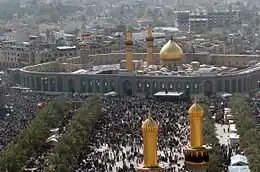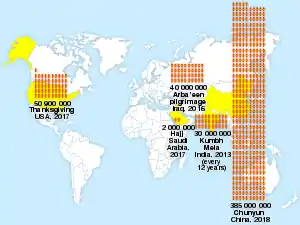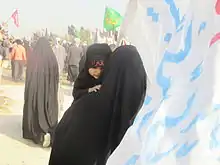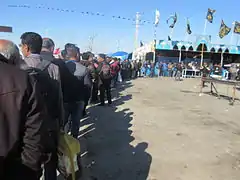Arbaʽeen Pilgrimage
The Arbaʽeen Pilgrimage, or the Arbaʽeen Walk, is one of world's largest annual public gathering that is held every year in Karbala, Iraq[1][2] at the end of the 40-day mourning period following Ashura, the religious ritual for the commemoration of martyrdom of the grandson of Prophet Mohammad and the third Shia Muslim Imam, Husayn ibn Ali's in 61 AH (680 AD).[3][4] Anticipating Arbaʽeen, or the fortieth day of the martyrdom, the pilgrims make their journey to Karbala on foot,[5] where Husayn and his companions were martyred and beheaded by the army of Yazid I in the Battle of Karbala.[1]
| Arbaʽeen Pilgrimage | |
|---|---|
 Millions of Muslims gather around the Husayn Shrine in Karbala after making a pilgrimage on foot during Arbaʽeen | |
| Status | Active |
| Genre | Religious gathering |
| Date(s) | Arbaʽeen, 20th day of Safar |
| Frequency | Annually |
| Country | Iraq |
| Participants | Shia Muslims |
| Capacity | More than 45 million |
| Part of a series on Islam Shia Islam |
|---|
 |
|
|
The number of participants in the annual pilgrimage reached 25 million or more by 2016.[6][7] On the routes of the pilgrimage, food, accommodation and other services are provided for free by volunteers.[8][9][10] Husayn is believed to transcend all cultural boundaries and be a symbol of universal freedom and compassion.[7]
Some of the pilgrims make their journey from cities as far as Basra, about 500 kilometres (310 mi) away by road.[11] The ritual has been described as "an overwhelmingly powerful display of Shia belief and solidarity".[8] Iran and Shias however have criticized mainstream media for ignoring the event.
Background
Jabir ibn Abd Allah alongside Atiyah ibn Sa'd were the first pilgrims of Husayn ibn Ali in the Arbaʽeen of 61 AH (AD 680). According to narrations, the custom of performing the pilgrimage on foot was forgotten during a time period after Morteza Ansari and it was revived by Mirza Husain Noori Tabarsi in an Eid al-Adha who repeated this action every year performing the last one by 1319 AH (AD 1901). Some other scholars and Marja's kept on the same manner in Arbaʽeen up to the Saddam's time[12] during which the pilgrimage was banned although a small number of people used to perform it secretly. It was revived just after Saddam's overthrow in 2003[4][12] and the number of participants grew year after year reaching 20 million pilgrims by 2016.[7]
Features

"Shia cities, towns and villages all over Iraq empty out" during the 20-day period of the pilgrimage "as their people take to the roads in an elaborately organised and well protected mass movement not seen anywhere else in the world".[8] By 2014, over 19 million people from 40 countries of the world participated in this occasion,[14][15][16] making it the second largest gathering in the world.[15] The figure reached 22 million pilgrims by 2015, according to Iraqi state-run media.[6] By 2016, according to al-Khoei Foundation, almost 22 million pilgrims gathered in Iraq, 10% more than 2014.[17] Even though the Hindu Kumbh Mela is larger in population, it is only held every four years, and hence the Arbaʽeen pilgrimage is the largest gathering held annually.[1]
The pilgrimage is marked by long walks from Najaf or Basra to Karbala. People from different walks of life, ethnicity and sect participate in the march[7] including toddlers in prams and elderly pushed in armchairs.[18]
Husayn ibn Ali, the Muslim saint for whom the pilgrimage is made, is believed to transcend all cultural boundaries and be a symbol of universal freedom and compassion.[7] The mood of the pilgrimage has also been described as "one of intense piety and communal solidarity".[8]
Free services
During the pilgrimage "copious supplies of food, small clinics and even dentists are available for pilgrims and they all work for free. The care of pilgrims is regarded as a religious duty."[8] Along the roads to Karbala, many mawakibs (tents) are devised with the aim of providing "accommodation, food and beverage and medical services",[9] and practically anything else the pilgrims need for free.[19]
The pilgrims carry flags of different color but the black flag of mourning for Imam Hussein is by far the most common. They also decorate "permanent brick buildings and temporary tents which are used for praying, eating and sleeping along the three main routes leading to Kerbala".[8] Seven thousand of such mawakeb were set up in city of Karbala in 2014.[10] Besides Iraqi mawakibs, which are unofficially organized, there are some Iranian ones which are less "specifically targeted" but pilgrims are from various regions.[20]
Ali Moamen, Academic and former director of Al Najaf Satellite TV Channel, said:
What is interesting about this human crowd is that all society segments take part in it. Despite its religious character, nonreligious people also participate in it, in addition to illiterates and holders of high academic degrees, and ordinary people and leaders of the country.[9]
According to Sayed Mahdi al-Modarresi, writing for The Huffington Post:
Arbaʽeen should be listed in the Guinness Book of World Records in several categories. The biggest annual gathering, longest continuous dining table, largest number of people fed for free, largest group of volunteers serving a single event, all under the imminent threat of suicide bombings.[14]
Comparison to Hajj
The Arbaʽeen pilgrimage is non-obligatory compared to Hajj which is obligatory for those who can afford it. But tight regulation of Hajj by Saudis have driven up costs and depriving it of spontaneity seen in Arbaʽeen, making the latter an alternative for Muslims who cannot afford Hajj. Arbaʽeen attracts more pilgrims than Hajj.[21]

Security arrangements
The pilgrims face dangers such as "attacks that have been blamed on Sunni extremists, who have routinely targeted the pilgrims" using car bombs or rockets.[5] The pilgrimage is performed under "tightened security" guarded by tens of thousands of Iraqi police and soldiers backed by armored vehicles and military helicopters to protect the pilgrims.[3] Iranian advisers also help protect the visitors through a joint operation room.[22] On 20 November 2015, a major bombing plot in Hussainiya in Iraq, Baghdad was foiled by the Iraqi police, where 18 booby-trapped dolls were seized by the security forces. Stuffed with bombs, were meant to be scattered on the roads leading to Karbala during Arbaʽeen.[23][24]
Political dimensions

The ritual is no longer considered a purely cultural ceremony while ISIL, the group who regards Shia as apostate, had launched a wide offensive in Iraq, and hence the presence of such a large population of Shia is of a political importance.[25][26] According to Ali Mamouri writing in Al-Monitor, the pilgrimage became "a show of force against those hostile to the rise of the Shia in the region". After the fall of Mosul to the ISIL "and the subsequent massacres of Shia soldiers and civilians", the gathering took a political form for the first time for the Shia, who use the mourning rituals as a way to condemn injustice and express their social power. "The second sign of Arbaʽeen's political shift was the regional message conveyed by Shia to their opponents: The Shia Crescent," Mamouri added. As the third sign he pointed to "a message exchanged between regional forces" and "unprecedented Iranian presence" which has led to "a feeling of solidarity between Arab and non-Arab Shia".[26]
Surveys are done to study Shi'a Muslims via both "traditional survey instruments and experimental methods".[20] The survey included topics such as "religion and politics, democracy, women's rights, regional conflict and Iran's nuclear agreement".[27] Experimental methods were employed to investigate the "latent perspectives" of pilgrims towards "sensitive topics", including "Iran's nuclear program, and attitudes toward the West, China and Russia".[20]
In the media
Allegations of media blackout
Iranian media, officials, religious figures and citizens have accused the Western media for ignoring the pilgrimage despite its large scale and its geopolitical and cultural significance.[28][29][30][31] Despite being even larger than Hajj, the most important Muslim pilgrimage to Mecca, the Arbaʽeen Pilgrimage remains largely unknown to the world.[32]
Asharq al-Awsat false report
In 2016, Asharq al-Awsat, a daily paper based in London, claimed the World Health Organization (WHO) reported that "unplanned pregnancies and [...] disease" were seen "following the arrival of scores of unregulated Iranians to take part in the annual Shia pilgrimage to Karbala", in reference to the Arbaʽeen Pilgrimage. According to the article, 169 unmarried women had become pregnant from the Iranian pilgrims. This report was later proven to be false.[33][34]
The WHO Regional Office for the Eastern Mediterranean rejected the claims reported in Asharq al-Awsat and condemned the inclusion of its name, calling it "unfounded" news.[34][35] In a television interview, a spokeswoman for the WHO said that the organization was "shocked" by Asharq al-Awsat's report and said that they were discussing with the Iraqi Ministry of Health on taking legal action against the paper.[36] Prime Minister of Iraq Haider al-Abadi and other Shiite leaders condemned the report and demanded an "apology".[34]
Around the world
Outside of Iraq, the pilgrimage is performed annually around the world in countries such as Nigeria, the United Kingdom, and the United States.[37]
United Kingdom
The Husaini Islamic Trust UK organizes a procession in United Kingdom which draws an attendance of thousands of people. In 2015, the organizers condemned terrorism following the November 2015 Paris attacks. The organizer said that the procession failed to gain coverage by the mainstream media because of "stereotyping", saying that "people see the entire Muslim community as one community."[37]
Nigeria
Pilgrims in West Africa who are unable to go to Karbala due to the distance involved instead head toward Zaria in Kaduna, Nigeria to be addressed by the Shia cleric Ibrahim Zakzaky. These include pilgrims from Nigeria as well as Ghana, Chad, Cameroon, Benin and Togo.[38]
On 5 October 2017, this annual Arbaʽeen trek was attacked by Kano police, resulting in the death of a religious leader and injury to dozens of participants. It was organised by the Islamic Movement of Nigeria which was previously a target of the 2015 Zaria massacre.[39]
Scholars' observations
In reference to 2017 Arbaʽeen pilgrimage, head of Iran's Islamic seminaries Ayatollah Alireza Arafi said "Arbaʽeen pilgrimage has truly become a manifestation of unity and brotherhood within Muslim community so much that even followers of other religions have been drawn to it and attend the ceremony alongside Shia Muslims."[40]
Gallery
.jpg.webp) A man grilling meat for pilgrims along the path of the Arbaʽeen Pilgrimage
A man grilling meat for pilgrims along the path of the Arbaʽeen Pilgrimage Arbaʽeen pilgrims waiting for receiving free food from mawkibs
Arbaʽeen pilgrims waiting for receiving free food from mawkibs A man holding a plate full of dates on his head for passing Arbaʽeen pilgrims
A man holding a plate full of dates on his head for passing Arbaʽeen pilgrims The 2015 Arbaʽeen Pilgrimage
The 2015 Arbaʽeen Pilgrimage
See also
| Wikimedia Commons has media related to Arba'een Pilgrimage. |
References
- Piggott, Mark. "20 Million Shia Muslims Brave Isis by Making Pilgrimage to Karbala for Arbaeen". IBtimes. Archived from the original on 24 September 2015. Retrieved 6 October 2015.
- "World's Biggest Pilgrimage". huffingtonpost.co.uk. Archived from the original on 26 November 2014. Retrieved 11 November 2017.
- Rasheed, Ahmed (24 December 2013). "Shi'ites finish Arbaeen pilgrimage in Iraq under tight security". Reuters. Archived from the original on 5 October 2015. Retrieved 3 October 2015.
- Staff writers (14 December 2014). "Shia pilgrims flock to Karbala for Arbaeen climax". BBC. Archived from the original on 29 September 2015.
- Karadsheh, Jomana (12 January 2012). "Shiite pilgrims make their way to Iraqi holy city amid tight security". CNN. Archived from the original on 5 October 2015. Retrieved 3 October 2015.
- Sim, David. "Arbaeen: World's largest annual pilgrimage as millions of Shia Muslims gather in Karbala". IB Times. Archived from the original on 7 December 2015. Retrieved 8 December 2015.
- "Arbaeen: a spiritual walk". The Nation. Retrieved 6 November 2017.
- "Free at last from Isis, millions of Muslims stage the greatest religious march in the world". The Independent. 9 November 2017. Retrieved 10 November 2017.
- Abu Zeed, Adnan. "Hoping for miracles, Shiites walk Iraq's Arbaeen pilgrimage". Archived from the original on 4 March 2016. Retrieved 4 October 2015.
- Staff writers (14 December 2014). "Arbaeen pilgrimage in Iraq: 17.5 million defy threat". SBS. Archived from the original on 7 October 2015. Retrieved 6 October 2015.
- Staff. "Millions of pilgrims throng Iraq's Karbala". Aljazeera. Archived from the original on 6 December 2015. Retrieved 8 December 2015.
- Staff writers. "The background of Arba'een rally/The importance of Najaf-Karbala rally from scholar's viewpoint". Fars News. Archived from the original on 16 November 2015. Retrieved 4 October 2015.
- McCarthy, Niall. "Chinese New Year: The World's Largest Human Migration Is About To Begin". Forbes.
- Dearden, Lizzie (25 November 2014). "One of the world's biggest and most dangerous pilgrimages is underway". The Independent. Archived from the original on 25 September 2015. Retrieved 4 October 2015.
- Philipson, Alice (19 January 2015). "The ten largest gatherings in human history". The Telegraph. Archived from the original on 6 October 2015. Retrieved 3 October 2015.
- Chandra Kharel, Gopi (13 December 2014). "Arbaeen 2014: 20 Million Pilgrims Flock to Karbala [PHOTOS]". Ibtimes. Archived from the original on 4 October 2015. Retrieved 4 October 2015.
- Cusack, Robert. "Iraq prepares for biggest Shia-Muslim Arbaeen gathering in history". alaraby. Retrieved 24 November 2016.
- "Almost 2 million Iranian pilgrims head into Iraq for Arbaeen". Retrieved 30 October 2018.
- al-Modarresi, Sayed Mahdi (24 November 2014). "World's Biggest Pilgrimage Now Underway, And Why You've Never Heard of it!". The Huffington Post. Archived from the original on 13 October 2015. Retrieved 8 October 2015.
- Christia, Fotini; Dekeyser, Elizabeth; Knox, Dean. "Shiites are participating in the world's largest pilgrimage today. Here's how they view the world". Washington Post. Archived from the original on 23 November 2016. Retrieved 24 November 2016.
- agencies, The New Arab &. "Millions of Shia pilgrims trek to Iraq's Karbala for Arbaeen". alaraby. Retrieved 30 October 2018.
- GEORGE, SUSANNAH. "Millions of Shiite pilgrims flock to Iraqi holy city for annual Arbaeen commemorations". Archived from the original on 10 December 2015. Retrieved 8 December 2015.
- Varghese, Johnlee (20 November 2015). "Booby-trapped dolls seized in Baghdad; Isis planned bomb blasts during Arbaeen". International Business Times. Archived from the original on 20 November 2015. Retrieved 21 November 2015.
- "Iraqi security forces dismantled 18 booby-trapped dolls in Baghdad". Kuwait News Agency. Shuwaikh. 20 November 2015. Archived from the original on 21 November 2015. Retrieved 21 November 2015.
- Staff writers (12 December 2014). "Iraq security fears as millions of pilgrims gather in Karbala". The National. Agence France-Presse. Archived from the original on 5 October 2015. Retrieved 5 October 2015.
- Mamouri, Ali. "Iraqi Shiite pilgrimage takes political turn". Al-Monitor. Archived from the original on 17 November 2015. Retrieved 8 October 2015.
- Christia, Fotini; Dekeyser, Elizabeth; Knox, Dean (24 October 2016). "Mapping Shiite Opinion". Foreign Affairs. Archived from the original on 25 November 2016. Retrieved 24 November 2016.
- YJC, خبرگزاری باشگاه خبرنگاران | آخرین اخبار ایران و جهان |. "سانسور رسانه های غربی در مقابل بزرگترین پیاده روی جهان". خبرگزاری باشگاه خبرنگاران | آخرین اخبار ایران و جهان | YJC (in Persian). Retrieved 9 November 2017.
- YJC, خبرگزاری باشگاه خبرنگاران | آخرین اخبار ایران و جهان |. "واکنش کاربران به سانسور راهپیمایی اربعین در رسانه های غربی +تصاویر". خبرگزاری باشگاه خبرنگاران | آخرین اخبار ایران و جهان | YJC (in Persian). Retrieved 9 November 2017.
- آقاپور, هدیه. "روزنامه كيهان96/8/16: پيام زائران اربعين در سكوت رسانه هاي استكبار". www.magiran.com. Retrieved 9 November 2017.
- "No one covered the Muslim anti-Isis march that took place in London last week". The Independent. 9 December 2015. Retrieved 9 November 2017.
- "You probably haven't heard about this Muslim pilgrimage in defiance of Isis". The Independent. 24 November 2016. Retrieved 9 November 2017.
- "Are scores of Iraqi women being impregnated by Iranian pilgrims?". Al Bawaba. 20 November 2016. Archived from the original on 25 November 2016. Retrieved 23 November 2016.
- "Saudi paper sacks Iraq correspondent over 'fake' report". NST Online. Agence France-Presse. Archived from the original on 22 November 2016. Retrieved 23 November 2016.
- "بيان إعلامي: منظمة الصحة العالمية تنفي خبراً كاذباً عن العراق". WHOofficial website. Archived from the original on 22 November 2016. Retrieved 23 November 2016.
- "WHO: Saudi Media Claims on Iraq Report "Unfounded"". Al manar. Archived from the original on 22 November 2016. Retrieved 23 November 2016.
- Sandhu, Serina (9 December 2015). "Muslim anti-Isis march not covered by mainstream media outlets, say organisers". The Independent. Archived from the original on 19 December 2015. Retrieved 18 December 2015.
- Müller, Friederike. "Nigerian Shiites brave terror threat". Deutsche Welle. Archived from the original on 22 December 2015. Retrieved 18 December 2015.
- ABNA (5 November 2017). "Two martyred as Nigerian police raid Arbaeen commemoration". Retrieved 9 November 2017.
- News, Hawzah (6 November 2017). "Arbaeen walk led to ISIS defeat: Head of Iran's seminaries". Retrieved 7 November 2017.